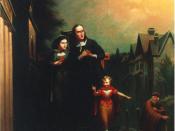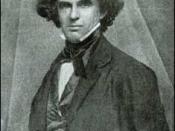"The Scarlet Letter" by Nathaniel Hawthorne is a result of the literary struggle between Classicism and Romanticism. This struggle is plainly embodied in the character of Hester Prynne, who must contain her passionate personality to the guidelines placed before her in a strict Puritan society. In a Puritan society, committing a sin is viewed as the worst possible thing one could do and one must be punished accordingly for it. In the eyes of the Puritan society Hester was truly a sinful woman, and as a result death and tragedy occurred.
Within the Scarlet Letter the theme was basically based around sin. All of the characters within the novel were affected by the sin, which was adultery. In chapter 24 the exposure of Dimmesdale's breast is taken differently by the people. Some believed that there was really a scarlet letter there, a mark of his sinfulness, others believed that Dimmesdale had carved it there himself as self-inflicted punishment.
This was the effect it played in the entire novel, it was if no one could escape it. The Puritans easily found fault in the weaknesses of others, they gathered at the scaffold to witness Hester's public humiliation. When she stood upon the scaffold this "A" unfamiliarized and separated her from the community. This sin she had committed had caused her to think of death as an easy way out and that she deserved nothing, for she says, "I have thought of death, have wished for it, would have even prayed for it, were it fit that such as I should pray for anything"(pg. 55 chpt.4). Once a beautiful woman, Hester now looks plain and drab. She had contained a precious quality of womanhood that has now faded away. Nathaniel Hawthorne attempts to show how guilt can be a form of everlasting punishment.
Which is worse to take a crime and hide it from the world or to confess it openly unto the world and take the consequences good or bad? Does the guilt eat away at you and you eventually tell anyway or not? If so why tell to begin with? In the opinion of the author, I think that it is worse to take internal punishment than external because external eventually will deteriorate, unlike internal that will stay hidden with you until your grave unless you break down so much it is no longer needed to hide your secret any longer.
Hester Prynne was the type of person that hid her feelings both from herself and the people around her. After Pearl continued to ask her what the "A" stood for she would always insist on telling her that "There are many things in this world that a child must not ask about" (pg.138 chpt.15). She did not want to have to admit to her daughter what it really stands for even though Pearl already knew. Pearl just wanted her mothe to be able to admit, accept what she had done, everybody makes mistakes. The way Hester thought of herself somehow affected her appearance because she felt that there was nothing else for her to do in life, it was over. Her plain gray clothes symbolize her temperament and disposition. The sin stays with her throughout her life, and even when she leaves her town, she feels obligated to come back and fulfill her punishment. The sin made her lifestyle worse, but it changed her character somewhat for the better. Her and Dimmesdale were more loving towards each other, "life had never brought them a gloomier hour; it was the point whither their pathway had so long been tending, and darkening ever, as it stole along; and yet it unclosed a charm that made them linger upon it, and claim another, and another, and, after all, another moment"(pg.150-151 chpt.17).
To Hester Prynne, it bore the full weight of her shame until she was able to reconcile herself to God and to the rest of the puritan community and to Arthur Dimmesdale, it burned into his heart the secret of his unbearable guilt and contributed to his eventual demise. Hester Prynne is definitely a dynamic character. She has changed for the better by becoming more mature and compassionate, and is an overall good person. She is also a very symbolic character, in the sense that she symbolizes the changes that people go through, and the consequences of breaking moral and social codes of behavior.
In God's view, everyone is a sinner in need of mercy. Who has the right to punish a sinner? Should it be religion or the individual? In Hawthorne's Scarlet Letter all three affected Hester Prynne. Religion punishes her with the "A" and individually she was able to move on in life but still returned to her haunting past where she died.





